Effect of Timing of Cluster Thinning on Cabernet Franc Wine Quality (2017)
Jordan Harris
Tarara Winery
Summary
This study examines the impact of the date of cluster thinning on juice and wine chemistry. The goal was to attempt to dilute the impact of potassium uptake during veraison by cluster thinning at later dates, in order to keep the pH lower. A block of Cabernet Franc was cluster thinned either pre-veraison (around Mid-August), halfway through veraison (around the end of August), and post-veraison (first or second week of September). Every third row received one of these treatments, so that treatments were evenly dispersed throughout the block to minimize variation. All grapes were harvested on the same day, and all other treatments between each juice and wine lot were identical. The later the clusters were dropped, the higher the average berry and cluster weight. The later the clusters were dropped, the lower the Brix and phenolic compounds. YAN was slightly higher in later cluster thinning sweeps. In general, wine made from later cluster dropping had slightly less ethanol, and slightly higher TA and tartaric acid. Color intensity was decreased with later cluster thinning, as were most phenolic compounds. Thus, earlier cluster thinning tended to enhance grape “ripeness” characteristics. For the descriptive analysis, there was a strong tendency for the 50% veraison treatment to have higher Herbaceous/Green character (LSD=0.43). There was a slight tendency for this wine to also have higher Bitterness. Pre-veraison cluster thinning may have had higher Fruit Intensity. Post-veraison cluster thinning may have had slightly lower Overall Aromatic Intensity and Astringency. In general, the wines which were cluster thinned at 50% veraison were most preferred. These results suggest that the beneficial impacts of cluster thinning prior to veraison on chemistry may not be beneficial towards flavor profiles. However, this study should be repeated over multiple vintages, at different sites, and with different grape varieties to better understand how this timing of cluster thinning affects a Virginia appellation.
Introduction
Cluster thinning is thought to be a useful crop management technique in that it increases the leaf area to fruit yield ratio (Bubola et al. 2017), potentially allowing for more photosynthetic energy to be supplied to the fruit. This is an example of the source-sink relationship, with leaves being the photosynthetic source of carbohydrates and fruit being the sink. The true relationship, however, is more complex. The effects of cluster thinning are often very mixed. Many studies have found that cluster thinning improves grape and wine quality (Fisher et al. 1977; Kasimatis 1977; Kliewer et al. 1983; Bravdo et al. 1984; McCarthy et al. 1987; Dokoozlian and Hirschfeldt 1995; Guidoni et al. 2002; Ferree et al. 2003; Dami et al. 2006; Bubola et al. 2011; Pastore et al. 2011; Kok 2011; Gatti et al. 2012; Avizcuri-Inac et al. 2013; Gil et al. 2013) but many others have found that cluster thinning has very little to no effect (Ough and Nagaoka 1984; Keller et al. 2005, Nuzzo and Matthews 2006).
Cluster thinning can result in an increase in juice soluble solids, higher pH, and lower acids (Winkler et al. 1974; Sinton et al. 1978; Looney 1981; Morris and Cawthon 1981; Galet 1983; Champagnol 1984; McCarthy et al. 1987; Reynolds 1989; Jackson and Lombard 1993; Ferree et al. 2003; Gil et al. 2013). Because the lower cluster on the shoot is generally more further advanced in terms of ripening than the upper cluster, cluster thinning should remove the upper cluster (Wolpert et al. 1983; Jackson and Lombard 1993).
Cluster thinning does not always result in an increase in sugar accumulation, but in these cases secondary metabolites can still be affected (Naor et al. 2002; Pastore et al. 2011; Kok 2011; Šuklje et al. 2013; Herrera et al. 2015). The quality changes in cluster thinning usually involve an increase in anthocyanin and phenolic content with variable degrees of efficacy (Kliewer and Weaver 1971; Jackson and Lombard 1993; Dokoozlian and Hirschfeldt 1995; Reynolds et al. 1995; Mazza et al. 1999; Guidoni et al. 2002; Bubola et al. 2011; Pastore et al. 2011; Gatti et al. 2012; Avizcuri-Inac et al. 2013; Gil et al. 2013), but other studies show very little impact of these practices on these qualities (Ough and Nagaoka 1984; Keller et al. 2005, Nuzzo and Matthews 2006; Bubola et al. 2017). In one study of Sauvignon blanc, cluster thinning did not affect fruit chemistry (except for pH) but had a significant impact on terpenes that was timing-dependent (Kok 2011). Some studies have shown that crop-thinned vines produce wines with higher sensory scores even with little to no chemical differences between them (Bravdo et al. 1984; Ough and Nagaoka 1984; Naor et al. 2002), suggesting that other flavor compounds may be impacted in ways that are difficult to measure (Jackson and Lombard 1993). However, these sensory differences are often very slight (Ough and Nagaoka 1984).
The timing of cluster thinning may also have an effect on its impact. Generally, it is thought that cluster thinning should be performed before veraison (Jackson and Lombard 1993). As one delays cluster thinning to be closer and closer to veraison, cluster weight and juice pH tends to increase (Dokoozlian and Hirschfeldt 1995; Ferree et al. 2003). However, soluble solids (although often increased by cluster thinning), are not as affected by the timing of cluster thinning (Ferree et al. 2003; Kok 2011). Secondary metabolites may be affected by the timing of cluster thinning. Sauvignon blanc cluster thinned for multiple delays past bloom showed increasing and then decreasing amounts of terpenes, with the highest concentration occurring at cluster thinning 8 weeks after bloom (Kok 2011). Vines that are thinned before bloom or 4 weeks after bloom can have higher color than unthinned vines and vines thinned 6 weeks after bloom (Dokoozlian and Hirschfeldt 1995).
However, the vine can compensate the source sink relationship when either one or the other is affected. If clusters are removed at bloom or just after, the vine might compensate by lowering leaf photosynthetic activity (since less sink is available which requires it) (Hofäcker 1978, Edson et al. 1995a, Naor et al. 1997). The reduced fruit sink may cause the vine to reduce the vegetative sink requirements and reduce vegetative growth (Eibach and Alleweldt 1985, Edson et al. 1995b), since growing more leaves would result in an excess supply of photosynthate for a low demand (Hofäcker 1978). This could result in no difference in ripening kinetics. Because of this difficulty, some have suggested that cluster thinning should be delayed until shoot growth has slowed down, which may be a time when the vine is already “primed” to divert resources to fruit (Keller et al. 2005). Others have found that the vegetative growth of the vine can increase as well from cluster thinning (Dami et al. 2006). The vine compensates as much as possible for losses, and the compensation can take various forms depending on the timing of these losses. This also carries over into cluster and berry size from cluster thinning. When crop is removed, the overall yield is not proportional to the percentage of clusters dropped, since the remaining clusters tend to weigh more and have larger berries (Ough and Nagaoka 1984; Guidoni et al. 2002; Dami et al. 2006). In general, if 2/3 of clusters are removed after bloom it will only result in a 1/3 decrease in yield (Ough and Nagaoka 1984).
The discrepancy among results suggest that cluster thinning is only truly of value in cases of overcropping (Keller et al. 2005, Nuzzo and Matthews 2006; Bubola et al. 2017), which generally delays ripening and reduces acidity, color, quality, vine size, and wood maturity (Weaver et al. 1957; Balasubrahmanyam et al. 1979; Winkler et al. 1974; Jackson and Lombard 1993). Diminishing returns are seen as more and more crop is thinned (Kasimatis 1977; Kliewer et al. 1983; Bravdo et al. 1984) further suggesting that there is an optimal yield level for fruit ripening. The impact of cluster thinning is also related to grape variety and growing region (Jackson and Lombard 1993; Bubola et al. 2017). Indeed, most studies which suggest relationships between yield and quality are either performed in cool climates with ripening difficulties (Reynolds 1989; Keller et al. 2005) or from very high-yield vineyards (Sinton et al. 1978; Bravdo et al. 1984). Alpha climatic zones cause grapes to ripen more slowly and thus overcropping is a large issue, whereas Beta zones generally do not have much ripening difficulties. Additionally, irrigated vines tend to benefit more from cluster thinning than unirrigated vines (McCarthy et al. 1987), further suggesting that growing and climatic conditions affect the efficacy of cluster thinning. Much of the research on leaf area to yield balance does not take adequate account of climactic conditions, which may account for the discrepancies in results (Jackson and Lombard 1993). In spite of this, many (if not most) winemakers cluster thin even with adequate leaf area to yield ratio (Kliewer and Dokoozlian 2005) or with adequate climatic conditions, with either little benefit or resulting in overripeness (Herrera et al. 2015). Undercropping is often the result, which can produce grapes with increased acidity, salts, nitrogen, and overall less balance (Sinton et al. 1978). A summary of the impact of different management practices on grape chemistry is given in Table 2 below (Jackson and Lombard 1993).
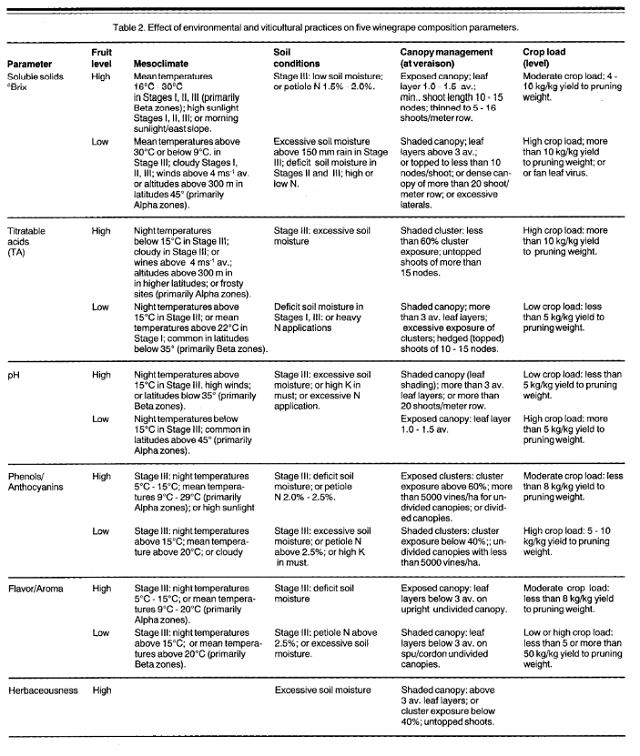
Adapted from Jackson and Lombard 1993
Generally, 0.8 to 1.2 m2 leaf area/kg fruit yield is considered to be an adequate leaf area to yield ratio to ripen most grape varieties (Kliewer and Dokoozlian 2001). A decline in ripening can often be seen when the ratio is reduced to 0.7-1.0 m2/kg (May et al. 1969; Kliewer and Antcliff 1970; Kliewer and Weaver 1971; Smart 1985; Kaps and Cahoon 1986; Kaps and Cahoon 1992). Increasing above 1.0 m2/kg sometimes decreases acidity and increases pH (Jackson 1986), but not always (Kaps and Cahoon 1992). Increasing above 1.0 m2/kg generally does not impact sugar accumulation. Vegetative growth is often increased by continually increasing this ratio. These considerations have resulted in the aforementioned optimal range.
Because of the impact of cluster thinning on yield, and the labor costs involved in cluster thinning, other techniques should be sought which have similar effects as cluster thinning without the impact on yield. In high vigor varieties, it may be the case that early leaf removal may be more beneficial for fruit quality than cluster thinning. Not only does early leaf thinning result in similar increases in quality as cluster thinning, but it also alters the microclimate of the fruiting zone in beneficial ways not usually gained through cluster thinning (Bubola et al. 2017). Berry thinning may have similar effects as cluster thinning without impacting yield as much (Gil et al. 2013). More research should be performed on alternatives to cluster thinning.
This study examines the impact of the timing of cluster thinning on Cabernet Franc grapes. Clusters were thinned either prior to veraison, 50% of the way through veraison, or after veraison.
Results and Discussion
The later the clusters were dropped, the higher the average berry and cluster weight. The later the clusters were dropped, the lower the Brix and phenolic compounds. YAN was slightly higher in later cluster thinning sweeps. In general, wine made from later cluster dropping had slightly less ethanol, and slightly higher TA and tartaric acid. Color intensity was decreased with later cluster thinning, as were most phenolic compounds. Thus, earlier cluster thinning tended to enhance grape “ripeness” characteristics.
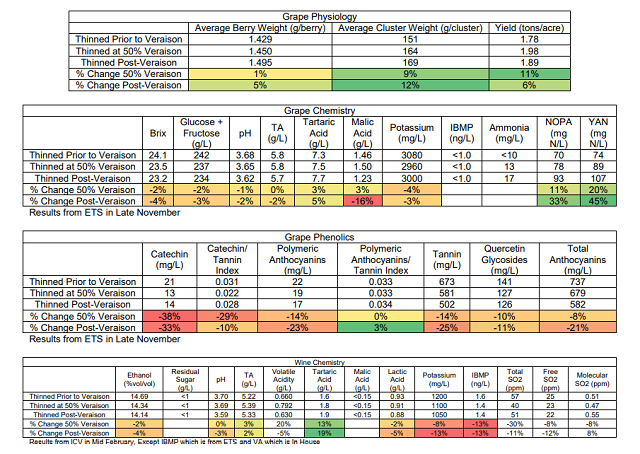
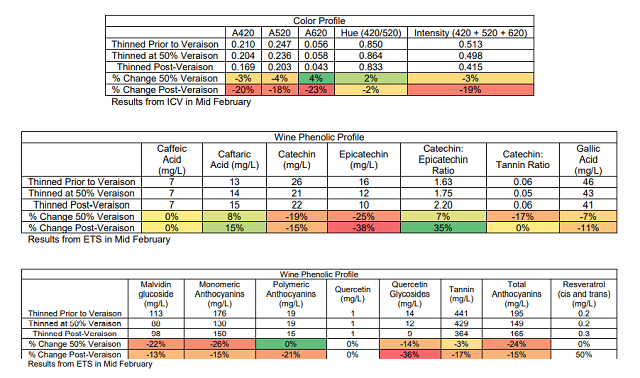
For the March 14 tasting, Astringency and Bitterness seemed to be higher for cluster thinning before and after veraison. Fruit Intensity seemed to be higher than 50% and post-veraison cluster thinning. There was a preference for the 50% cluster thinning wine. However, this tasting had very low attendance, and thus these results are very weak.
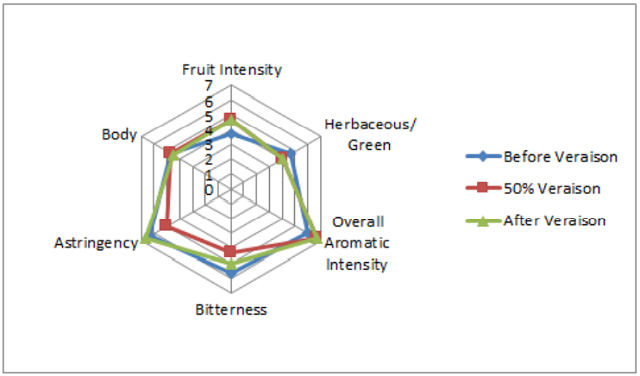
For the descriptive analysis on the May 16 tasting, there was a strong tendency for the 50% veraison treatment to have higher Herbaceous/Green character (LSD=0.43). There was a slight tendency for this wine to also have higher Bitterness. Pre-veraison cluster thinning may have had higher Fruit Intensity. Post-veraison cluster thinning may have had slightly lower Overall Aromatic Intensity and Astringency. In general, the wines which were cluster thinned at 50% veraison were most preferred. These results suggest that the beneficial impacts of cluster thinning prior to veraison on chemistry may not be beneficial towards flavor profiles. However, this study should be repeated over multiple vintages, at different sites, and with different grape varieties to better understand how this timing of cluster thinning affects a Virginia appellation.
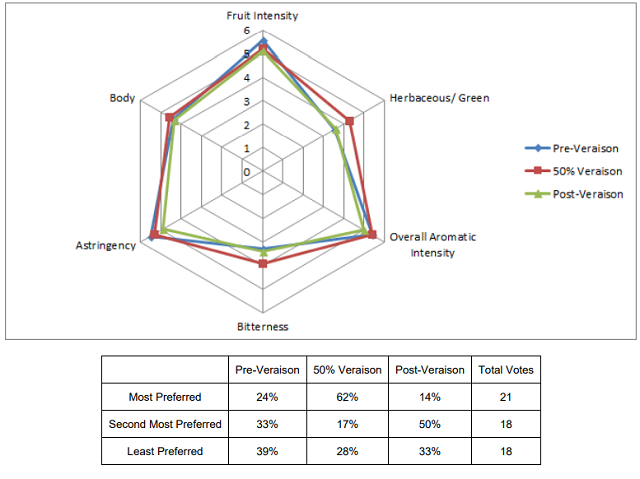
Methods
This project was performed on a 2.19 acre block of Cabernet Franc first planted in 1989. This block was on silt loam and limestone with a moderate south facing slope (14 rows). Three different cluster thinning timings were performed on this block so that the entire block was thinned to 1 cluster per shoot in the end. The first 1/3 was thinned prior to veraison (around mid-August) and the bottom cluster was left (unless it was underperforming), the second 1/3 was thinned at 50% veraison (around late August) and the selection was made based on the cluster that was furthest advanced, and the last 1/3 was thinned post veraison (around the first-second week of September), leaving the bottom cluster unless it was underperforming. All other tasks in the block were done identically so the only difference was the cluster removal process. It was done alternating rows (every third row had the same treatment) to ensure uniformity.
Grapes were harvested on October 7, 2017 and chilled overnight. The following day they were destemmed into 1 ton T Bins, and each lot received 2g/L tartaric acid. All lots received a 10 day cold soak, and were then inoculated with CSM and Go Ferm. YAN was corrected to 225ppm using 25g/hL Fermaid and the remainder DAP over three days. Punchdowns were three times per day starting at the beginning of fermentation. Post-fermentation punchdowns were once per day until the cap fell. The wines were pressed on November 13 (36 days total maceration), and only the free run was used. The wines were pressed directly to barrel. All wines were inoculated with O-Mega malo-culture in barrel. Each wine was barreled into a second use Sansaud French Xtra Medium Plus barrel.
These wines were tasted on March 14 and May 16. In order to balance the data set to perform statistical analysis for descriptive analysis on the May 16 tasting, any judge who had not fully completed the descriptive analysis ratings were removed. In order to then make the number of judges between groups equivalent, one judge from group 3 was transferred to group 1. This resulted in a final data set of 3 groups, each with 6 judges (considered as replications within groups, and groups were considered as assessors). Data was analyzed using Panel Check V1.4.2. Because this is not a truly statistical set-up, any results which are found to be statistically significant (p<0.05) will be denoted as a “strong trend” or a “strong tendency,” as opposed to general trends or tendencies. The statistical significance here will ignore any other significant effects or interactions which may confound the results (such as a statistically significant interaction of Judge x Wine confounding a significant result from Wine alone). The descriptors used in this study were Fruit Intensity, Herbaceous/Green, Overall Aromatic Intensity, Bitterness, Astringency, and Body.
Due to the very small number of judges (3) at the March 14 tasting, only slight trends will be discussed for the sensory information. Its results will not be incorporated into the overall conclusions.
References
Avizcuri-Inac, J.M., Gonzalo-Diago, A., Sanz-Asensio, J., Martínez-Soria, M.T., López-Alonso, M., Dizy-Soto M., Echávarri-Granado, J.F., Vaquero-Fernández, L., and Fernández-Zurbano, P. 2013. Effect of cluster thinning and prohexadione calcium applications on phenolic composition and sensory properties of red wines. J Agric Food Chem 61:1124-1137.
Balasubrahmanyam, V. R., Eifert, J., and Diofasi, L. 1979. Vine behaviour and wine composition in Italian Riesling grapes as influenced by differential cropping levels. Vitis 18:122-6.
Bravdo, B., Hepner, Y., Loinger, C., Cohen, S., and Tabacman, H. 1984. Effect of crop level on growth, yield and wine quality of a high yielding Carignane vineyard. Am. J. Enol. Vitic. 35:247-252.
Bubola, M., Paolo Sivilotti, P., Janjanin, D., and Poni, S. 2017. Early leaf removal has larger effect than cluster thinning on cv. Teran grape phenolic composition. Am. J. Enol. Vitic. In Press.
Bubola, M., Peršurić, D., and Kovačević, Ganić K. 2011. Impact of cluster thinning on productive characteristics and wine phenolic composition of cv. Merlot. J Food Agric Environ 9:36-39.
Champagnol, F. 1984. Elements de Physiologie de la Vigne et de Viticulture G~n&ale. Pub. The Author, Montpellier.
Dami, I., Ferree, D., Prajinitna, A., and Scurlock, D. 2006. A five-year study on the effect of cluster thinning on yield and fruit composition of ‘Chambourcin’ grapevines. HortScience. 41:586-588.
Dokoozlian, N.K., and Hirschfeldt, D.J. 1995. The influence of cluster thinning at various stages of fruit development on Flame seed-less table grapes. Am. J. Enol. Vitic. 46:429-436.
Edson, C.E., Howell, G.S., and Flore, J.A. 1995a. Influence of crop load on photosynthesis and dry matter partitioning of Seyval grapevines. II. Seasonal changes in single leaf and whole vine photosynthesis. Am. J. Enol. Vitic. 46:469-477.
Edson, C.E., Howell, G.S., and Flore, J.A. 1995b. Influence of crop load on photosynthesis and dry matter partitioning of Seyval grapevines. III. Seasonal changes in dry matter partitioning, vine morphology, yield, and fruit composition. Am. J. Enol. Vitic. 46:478-485.
Eibach, R., and Alleweldt, G. 1985. Einfluss der Wasserversorgung auf Wachstum, Gaswechsel und Substanzproduktion traubentragender Reben. III. Die Substanzproduktion. Vitis 24:183-198.
Ferree, D.C., Cahoon, G.A., Scurlock, D.M., and Brown, M.V. 2003. Effect of Time of Cluster Thinning Grapevines. Small Fruits Review. 2: 3-14
Fisher, K. H., Bradt, O.A., Wiebe, J., and Dirks, V.A. 1977. Cluster thinning 'de Chaunac' French hybrid grapes improves vine vigor and fruit quality in Ontario. J. Am. Soc. Hortic. Sci. 102:162-5.
Galet, P. 1983. Precis de Viticulture. D~han, Montpellier (4 th Edition), 584 pp.
Gatti, M., Bernizzoni, F., Civardi, S., and Poni, S. 2012. Effects of cluster thinning and preflowering leaf removal on growth and grape composition in cv. Sangiovese. Am J Enol Vitic 63:325-332.
Gil, M., Esteruelas, M., González, E., Kontoudakis, N., Jiménez, J., Fort, F., Canals, J.M., Hermosín-Gutiérrez, I., and Zamora, F. 2013. Effect of two different treatments for reducing grape yield in Vitis vinifera cv Syrah on wine composition and quality: Berry thinning versus cluster thinning. J. Agric. Food Chem. 61:4968-4978
Guidoni, S., Allara, P., and Schubert, A. 2002. Effect of cluster thinning on berry skin anthocyanin composition of Vitis vinifera cv. Nebbiolo. Am. J. Enol. Vitic. 53:224-226.
Herrera, J.C., Bucchetti, B., Sabbatini. P., Comuzzo, P., Zulini, L., Vecchione, A., Peterlunger, E., and Castellarin, S.D. 2015. Effect of water deficit and severe shoot trimming on the composition of Vitis vinifera L. Merlot grapes and wines. Aust J Grape Wine Res 21:254-265.
Hofäcker, W. 1978. Untersuchungen zur Photosynthese der Rebe. Einfluss der Entblätterung, der Dekapitierung, der Ringelung und der Entfernung der Traube. Vitis 17:10-22.
Jackson, D. I. 1986. Factors affecting soluble solids, acid, pH, and color in grapes. Am. J. Enol. Vitic. 37:179-83.
Jackson, D.I. and Lombard, P.B. 1993. Environmental and management practices affecting grape composition and wine quality: A review. Am. J. Enol. Vitic. 44:409-430.
Kaps, M. L., and Cahoon, G.A. 1986. Influence of leaf area adjustment, leaf position in relation to a basal cluster, and lower leaf shading on grapevine productivity. HortScience 21 (3) Abstract No. 851.
Kaps, M. L., and Cahoon, G.A. 1992. Growth and fruiting of container-grown Seyval blanc grapevines modified by changes in crop level, leaf number and position, and light exposure. Am. J. Enol. Vitic. 43:191-9.
Kasimatis, A. N. 1977. Differential cropping levels of Zinfandel wines – a progress report on some effects on vine growth, fruit composition and wine quality. In: Proceedings of the OIV International Symposium on Quality of the Vintage, Oenological and Viticulture Research Institute, Capetown. Pp 189-94.
Keller, M., Mills, L.J., Wample, R.L., and Spayd, S.E. 2005. Cluster thinning effects on three deficit-irrigated Vitis vinifera cultivars. Am J Enol Vitic 56:91-103.
Kliewer, W. M., and Antcliff, A.J. 1970. Influence of defoliation, leaf darkening, and cluster shading on the growth and composition of Sultana grapes. Am. J. Enol. Vitic. 21:26-36.
Kliewer, W. M., and Weaver, R.J. 1971. Effect of crop level and leaf area on growth, composition and coloration of 'Tokay' grapes. Am. J. Enol. Vitic. 22:172-7.
Kliewer, W. M., Freeman, B.M., and Hossom, C. 1987. Effect of irrigation, crop level and potassium fertilization on Carignane vines. I. Degree of water stress and effect on growth and yield. Am. J. Enol. Vitic. 34:186-196 (1983). (Ed.) pp 75-7.
Kliewer, W.M. and Dokoozlian, N.K. 2005. Leaf area/crop weight ratios of grapevines: Influence on fruit composition and wine quality. Am J Enol Vitic 56:170-181.
Kliewer, W.M. and Weaver, R.J. 1971. Effect of crop level and leaf area on growth, composition and coloration of ‘Tokay’ grapes. Am. J. Enol. Vitic. 23:172-177.
Kliewer, W.M., and Dokoozlian, N.K. 2001. Leaf area/crop weight ratios of grapevines: influence on fruit composition and wine quality. In Proceedings for the American Society for Enology and Viticulture 50th Anniversary Annual Meeting, Seattle, WA. J.M. Rantz (Ed.), pp. 285-295. ASEV, Davis, CA.
Kok, D. 2011. Influences and pre- and post-veraison cluster thinning treatments on grape composition variables and monoterpene levels of Vitis vinifera L. cv. Sauvignon Blanc. Journal of Food, Agriculture & Environment. 9:22-26.
Looney, N. E. 1981. Some growth regulator and cluster thinning effects on berry set and size, berry quality, and annual productivity of de Chaunac grapes. Vitis 20:22-35.
May, P., Shaulis, N.J., and Antcliff, A.J. 1969. The effect of controlled defoliation in the Sultana vine. Am. J. Enol. Vitic. 20:237-50.
Mazza, G., Fukumoto, L., Delaquis, P., Girard, B., and Ewert, B. 1999. Anthocyanins, phenolics, and color of Cabernet Franc, Merlot, and Pinot noir wines from British Columbia. J. Agric. Food Chem. 47:4009-4017.
McCarthy, M. G., Cirami, R.M., and Furkaliev, D.G. 1987. The effect of crop load and vegetative growth control on wine quality. In: Proceeding of the Sixth Australian Wine Industry Technical Conference, Adelaide: T. H. Lee (Ed.) pp 75-7.
Morris, J. R. and Cawthon, D.L. 1981. Yield and quality response of Concord grapes (Vitis labrusca L.) to mechanized vine pruning. Am. J. Enol. Vitic. 32:280-2.
Naor, A., Gal, Y., and Bravdo, B. 1997. Crop load affects assimilation rate, stomatal conductance, stem water potential and water relations of field-grown Sauvignon blanc grapevines. J. Exp. Bot. 48:1675-1680.
Naor, A., Gal, Y. and Bravdo, B. 2002. Shoot and cluster thinning influence vegetative growth, fruit yield, and wine quality of ‘Sauvignon blanc’ grapevines. J. Am. Soc. Hortic. Sci. 127:628-634.
Nuzzo, V. and Matthews, M.A. 2006. Response of fruit growth and ripening to crop level in dry-farmed Cabernet Sauvignon on four rootstocks. Am J Enol Vitic 57:314-324.
Ough, C.S., and Nagaoka, R. 1984. Effect of cluster thinning and vineyard yields on grape and wine composition and wine quality of Cabernet Sauvignon. Am. J. Enol. Vitic. 35:30-34.
Pastore, C., Zenoni, S., Tornielli, G.B., Allegro, G., Dal Santo, S., Valentini, G., Intrieri, C., Pezzotti, M., and Filippetti, I. 2011. Increasing the source/sink ratio in Vitis vinifera (cv Sangiovese) induces extensive transcriptome reprogramming and modifies berry ripening. BMC Genomics 12:631.
Reynolds, A.G. 1989. Riesling grapes respond to cluster thinning and shoot density manipulation. J. Am. Soc. Hortic. Sci. 114:364-368.
Reynolds, A.G., Douglas, A.W., Hall, J.W., and Dever, M. 1995. Fruit maturation of four Vitis vinifera cultivars in response to vineyard location and basal leaf removal. Am. J. Enol. Vitic. 46:542-558.
Sinton, T. H., Ough, C.S., Kissler, J.J., and Kasimatis, A.N. 1978. Grape juice indicators for prediction of potential wine quality. I. Relationships between crop level, juice and wine composition, and wine sensory ratings and scores. Am. J. Enol. Vitic. 29:267-71
Smart, R. E. 1985. Principles of grapevine canopy microclimate manipulation with implications for yield and quality. A review. Am. J. Enol. Vitic. 36:230-9.
Šuklje, K., Baša Česnik, H., Janeš, L., Kmecl, V., Vanzo, A., Deloire, A., Sivilotti, P., and Lisjak, K. 2013. The effect of leaf area to yield ratio on secondary metabolites in grapes and wines of Vitis vinifera L. cv. Sauvignon blanc. J Int Sci Vigne Vin 47:83-97.
Urban, L., Léchaudel, M., and Lu, P. 2004. Effect of fruit load and girdling on leaf photosynthesis in Mangifera indica L. J. Exp. Bot. 55:2075-2085.
Weaver, R. J., Amerine, M.A., and Winkler, A.J. 1957. Preliminary report on effect of level of crop on development of color in certain red wine grapes. Am. J. Enol. 4:157-66.
Winkler, A. J., Cook, J.A., Kliewer, W.M.,and Lider, L.A. 1974 General Viticulture. 710 p., Univ. of Calif. Press, Berkeley.
Wolpert, J. A., Howell, G.S., and Mansfield, T.K. 1983. Sampling Vidal Blanc grapes. I. Effect of training system, pruning severity, shoot exposure, shoot origin and cluster thinning on cluster weight and fruit quality. Am. J. Enol. Vitic. 34:72-6.
